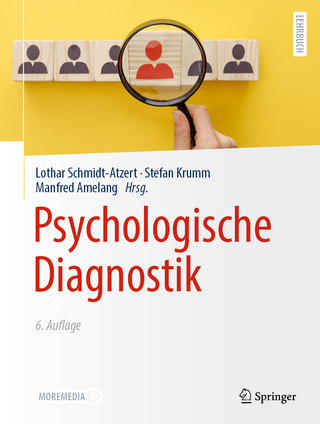
Forensic Psychology
John Wiley & Sons Inc (Verlag)
978-1-118-75778-9 (ISBN)
- Titel erscheint in neuer Auflage
- Artikel merken
Updated to reflect recent changes in the field, the 2nd Edition of Forensic Psychology presents a comprehensive overview of forensic psychology and its applications in the civil and criminal justice systems of the UK. * Builds on the first edition to convey material in an engaging manner to postgraduate students in psychology * Includes a significant expansion of pedagogical features, including text boxes highlighting key seminar issues and key debates in the field to further group discussion * Provides an up-to-date summary of emerging evidence in the field, and its implications for evidence based practice * Points to additional online learning resources at the conclusion of each chapter
David A. Crighton is a Consultant Psychologist and Honorary Professor of Forensic Psychology at Durham University UK. He is co-author of Psychology in Prisons, 2/e (2008). Graham J. Towl is Pro Vice Chancellor, Deputy Warden and Professor of Forensic Psychology at Durham University UK. He is the editor of Psychological Research in Prisons (2006) and co-author of Psychology in Prisons, 2/e (2008).
List of Contributors xix 1 Introduction 1 Graham J. Towl and David A. Crighton Justice 2 Expert Controversies 3 Thinking about Human Rights and Ethics 4 Developmental Perspectives 5 Investigation and Prosecution Issues 8 Psychological Assessment 8 Critical Psychology 9 Substance Use 11 Early Intervention 11 Justice Restored 12 References 12 PART I Investigative Practic e 15 2 The Justice System in England and Wales: A Case Study 17 David Faulkner What Justice Means 17 The Criminal Justice System 17 What is a Crime? 18 Measurement of Crime 19 The Criminal Justice Process 19 The Sentencing Framework 21 The Criminal Courts 22 Police and Policing 23 The Crown Prosecution Service 24 Prisons and the Prison Service 24 Probation 25 Youth Justice 25 Home Office 26 Ministry of Justice 26 Law Officers 27 Other National Bodies 27 Some Special Subjects 27 Conclusions 29 Notes 29 Further Reading 30 References 30 3 Offender Profiling 33 David A. Crighton Introduction 33 Historical Development 33 Approaches to Offender Profiling 35 Recent Developments 36 Profiling Databases 37 The Evidence Base for Profiling 37 Practice Issues 40 Conclusions 41 Notes 42 Further Reading 42 References 42 4 Eyewitness Testimony 45 Lorraine Hope Eyewitness Identification Performance 45 The Witnessed Event 46 Between the Witnessed Event and Identification Task 49 Intermediate Recognition Tasks 50 Identifications from CCTV 53 Procedural Guidelines Relating to Suspect Identification in the United Kingdom 55 The Eyewitness in Court 56 Conclusions 57 Further Reading 57 References 58 5 Jury Decision ]Making 65 Andreas Kapardis Introduction: The Jury Idea 65 The Notion of an Impartial and Fair Jury: A Critical Appraisal 66 Methods for Studying Juries/Jurors 67 Selecting Jurors 68 Pre-Trial Publicity 69 Juror Competence 70 Hung Juries 73 Models of Jury Decision ]Making 73 Reforming the Jury to Remedy Some of its Problems 73 Alternatives to Trial by Jury 73 Conclusions 74 Notes 74 Further Reading 75 References 75 6 Assessment 81 David A. Crighton Conceptual Issues in Assessment 81 Assessment 84 Data Gathering 88 Data Analysis 90 Clinical Judgements and Biases 92 Conclusions 93 Notes 94 Further Reading 94 References 94 7 Risk Assessment 97 David A. Crighton Key Legal Issues 97 Key Principles in Risk Assessment 98 Risk Assessment Instruments 100 Critical Issues in Risk Assessment 103 Conclusions 107 Notes 108 Further Reading 108 References 109 PART II Working with Offending Populati ons 113 8 The Developmental Evidence Base: Neurobiological Research and Forensic Applications 115 Robert A. Schug, Yu Gao, Andrea L. Glenn, Melissa Peskin, Yaling Yang and Adrian Raine The Developmental Evidence Base: Neurobiological Research 115 Genetics 116 Neuroimaging 116 Neurology 118 Neuropsychology 119 Psychophysiology 121 Endocrinology 123 Moral Development 124 Nutrition 124 Forensic Applications of Developmental Neurobiological Research 125 Conclusions 128 Further Reading 129 References 129 9 The Developmental Evidence Base: Prevention 141 David P. Farrington Introduction 141 Family ]Based Prevention 143 School ]Based Prevention 145 Peer Programmes 148 Skills Training 149 Communities that Care 150 Recent UK Developments 151 Conclusions 152 Further Reading 154 References 154 10 The Developmental Evidence Base: Psychosocial Research 161 David P. Farrington Introduction 161 Individual Factors 163 Family Factors 166 Social Factors 171 School Influences 172 Community Influences 173 Conclusions 174 Further Reading 174 References 175 11 The Developmental Evidence Base: Desistance 183 Lila Kazemian and David P. Farrington Current State of Knowledge on Desistance 183 Unresolved Issues in Desistance Research 190 Conclusions 193 Further Reading 194 References 194 12 Crisis Negotiation 201 David A. Crighton Conceptual Issues in Crisis Negotiation 201 To Negotiate or Not to Negotiate 204 Goals of Crisis Negotiation 204 Crisis Negotiation and Terrorism 206 Applying Principled Negotiation during Terrorist Incidents 207 The Process of Negotiation with Terrorists 208 The Experience of Hostages 208 Crisis Negotiation The Evidence 209 Conclusions 211 Notes 211 Further Reading 212 References 212 13 Aspects of Diagnosed Mental Illness and Offending 215 David Pilgrim The Social Context of Rule Transgressions: Normal and Abnormal Offenders 215 Overlaps and Tensions between Psychiatric and Psychological Knowledge 217 Psychological and Psychiatric Approaches to Mental Illness in Forensic Settings 220 The Problematic Relationship between Diagnosed Mental Illness and Risk 221 Conclusions 223 Further Reading 224 References 224 14 Intellectual Disability: Assessment 227 William R. Lindsay and John L. Taylor The Context of Practice in Forensic Learning Disabilities 227 Mental Health Legislation 228 Learning Disability and Crime 229 Applications of Psychology to Processes within the Justice System 235 Working with Offenders with ID 237 Conclusions on Assessment 244 Further Reading 245 References 245 15 Intellectual Disability: Treatment and Management 253 William R. Lindsay, John L. Taylor and Amanda Michie Treatment for Specific Needs 254 Conclusions 260 Further Reading 261 References 261 16 Personality Disorders: Assessment and Treatment 265 Conor Duggan and Richard Howard Issues Surrounding the Concept of PD 265 Measures of Interpersonal Style 270 Practical Considerations 271 Summary: Assessment of PD 271 Procedural Recommendations in Assessing PD 272 Treatment of PD: Some Caveats 272 Treatment Issues 273 Current Issues in the Assessment and Treatment of PD 275 Notes 276 Further Reading 276 References 277 17 Personality Disorders: Their Relation to Offending 281 Richard Howard and Conor Duggan Is Personality Disorder Linked to Offending? 281 How is Personality Disorder Linked to Violence? 282 Is Psychopathy Related to Violence? 283 Towards a Model of Personality Disorder and Violence 285 Notes 287 Further Reading 287 References 288 18 Beyond Disorder : A Psychological Model of Mental Health and Well-Being 291 Peter Kinderman Drop the Language of Disorder 291 Oppositional Defiant Disorder Really? 293 Moving Beyond the Concept of Abnormality 294 There is an Alternative to Diagnosis 295 Operationally Defined Problem Lists 295 The Drugs Do Not Work 296 Pathways to Mental Health 298 A Psychological Model of Mental Health and Well ]Being 298 Notes 299 Further Reading 299 References 299 19 Substance Use Disorders 301 Michael Gossop Consumption Behaviours, Problems and Dependence 301 Drugs and Crime 302 Assessment of Substance Use Disorders 303 Management of Detoxification 303 Treatment 305 Further Complications 309 Notes 311 Further Reading 311 References 312 20 Suicide and Self-Injury in Prisoners 315 Tammi Walker Context 315 Background 315 The Prison Population and Suicide 316 Suicide in Remand Prisoners 316 Suicide in Sentenced Prisoners 317 Suicide in Young Prisoners 318 Suicide in Released Prisoners 318 Suicide in Women Prisoners 319 Limitations of Suicide Research in Prison Settings 319 Psychosocial and Situational Risk Factors for Suicide Common to Prisons 320 Self-Injury in Prisoners 320 Risk Factors for Self-Injury in the Prison Population 321 Current Interventions and Treatments in Custody 322 Prison Staff Responses to Prisoners at Risk of Harm to Self 323 Conclusion 324 Further Reading 325 References 325 21 Working with Children and Adolescents with Harmful Sexual Behaviour 329 Jackie Walton Definitional Issues and the Use of Language 329 Historical Context Setting 330 Assessment and Treatment Interventions with Adolescents 331 Assessment and Treatment Work with Children 334 Conclusions 337 Further Reading 337 References 338 22 Sexually Harmful Adults 341 Belinda Brooks-Gordon Who and What is a Sexually Harmful Adult? 341 Prevalence and Incidence of Sexually Harmful Behaviours 341 Theories of Sexually Harmful Behaviour 342 Assessing the Risk of Sexually Harmful Adults 343 Interventions for Sexually Harmful Adults 344 Measuring Interventions 345 Past Meta-Analyses of Interventions with Sexually Harmful Adults 345 Improving the Quality of Treatment Outcome 347 Cluster Randomization 347 When the Sex Offender is Not Sexually Harmful 348 The Politicization of Sexual Harm 348 Sexual Harm and the Culture of Fear 349 Conclusions 350 Notes 350 Further Reading 350 References 351 23 Gang Members: Group Processes and Social Cognitive Explanations 353 Jane L. Wood Gang Membership 353 Gang Members: Delinquency Levels 353 Becoming a Gang Member: Group Processes 355 Gang Identity and Identifying with the Gang 355 Conformity, Pluralistic Ignorance and Cohesion 356 Intergroup Conflict and Status Enhancement 357 Being a Gang Member: Social Cognitive Processes 359 Moral Disengagement 359 Offence Supportive Cognitions 360 Rumination, Displaced Aggression and Entitativity 361 Conclusions 364 Further Reading 364 References 365 24 Genocide and Hate Crime 369 William Jacks and Joanna R. Adler What is Genocide? 369 What is Hate Crime? 371 Psychological Explanations of Genocide and Hate Crime 373 Nurturing Prejudice: Demonizing and Degrading the Out ]Group 374 Hate Crime: Beyond Group Explanations 375 Acting Out Prejudices: Psychological Processes that Facilitate Violence in Genocide 376 Passive Bystanders 376 Characteristics of Cultures Disposed to Genocide and Hate Crime 377 Rehabilitation of Hate Crime Offenders 378 Preventing Genocide 379 Summary 380 Notes 380 Further Reading 380 References 381 25 Restorative Justice as a Psychological Treatment: Healing Victims, Reintegrating Offenders 385 Lawrence W. Sherman and Heather Strang Introduction 385 Varieties of Restorative Justice 386 Theories of Change for Victims and Offenders 388 Delivering RJ Conferencing 389 Research on Restorative Justice: The Gold Standard 391 Effects of RJ Conferencing on Offenders 394 Effects of RJ Conferencing on Victims 396 Evidence on Other RJ Options 397 RJ and Forensic Psychology 398 Notes 399 Further Reading 399 References 401 PART III Et hical and Legal Issues 403 26 Ethical Issues in Forensic Psychological Policy and Practice 405 Graham J. Towl Philosophical Roots 405 Ethical Guidance for Professionals 407 Power Relationships 411 Conclusions 412 Further Reading 412 References 413 27 Risk and Resilience 415 Graham J. Towl The Concept of Risk in Forensic Psychological Policy and Practice 416 Do We Need to Think More about Ethical Issues in Risk Assessment? 417 Risk and Resilience 420 Biases in Human Decision-Making 421 Implications for Future Forensic Practice: Risk and Resilience 422 Further Reading 423 References 423 28 Structural Violence in Forensic Psychiatry 425 Brian A. Thomas-Peter Suffering in Forensic Psychiatry 426 Inquiries into Harm Done to Patients 427 Major Inquiries: Lessons Learned and Not Learned 427 Incidents, Complaints and Root Cause Analysis 430 Conclusion 434 Notes 434 Further Reading 435 References 435 29 Concluding Themes: Psychological Perspectives and Futures 437 Graham J. Towl Introduction 437 Contextual Themes 438 Psychological Perspectives 440 Futures 441 References 442 Index of Names 443 Index of Subjects 453
| Erscheint lt. Verlag | 4.5.2015 |
|---|---|
| Reihe/Serie | BPS Textbooks in Psychology ; 1 |
| Verlagsort | New York |
| Sprache | englisch |
| Maße | 217 x 277 mm |
| Gewicht | 1240 g |
| Themenwelt | Geisteswissenschaften ► Psychologie |
| ISBN-10 | 1-118-75778-5 / 1118757785 |
| ISBN-13 | 978-1-118-75778-9 / 9781118757789 |
| Zustand | Neuware |
| Informationen gemäß Produktsicherheitsverordnung (GPSR) | |
| Haben Sie eine Frage zum Produkt? |
aus dem Bereich



